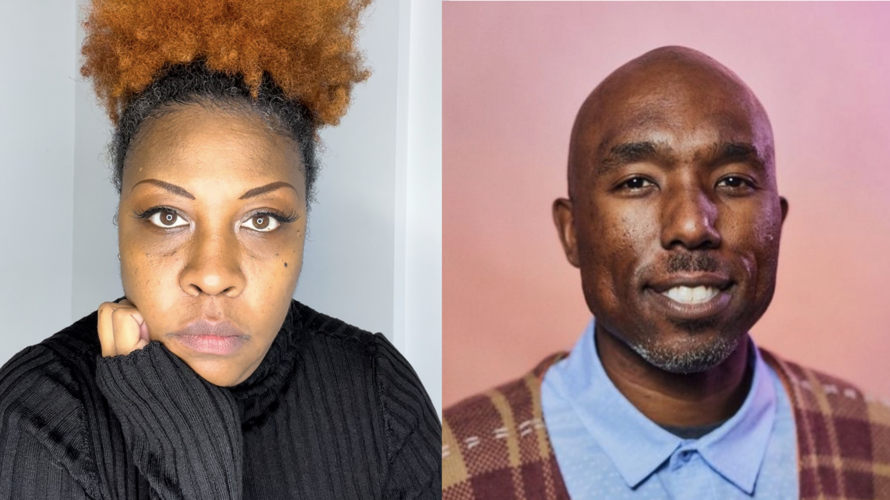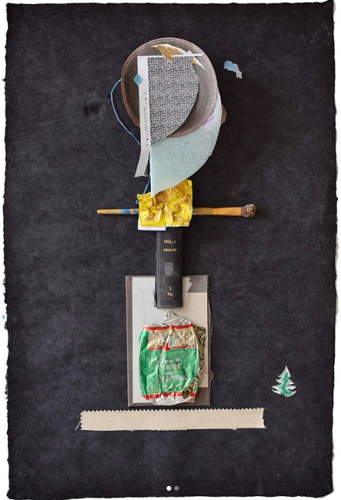EXPO Chicago, the city’s premier showcase of modern and contemporary art, returns to Navy Pier this week. Alongside the main event, a number of satellite shows will take place throughout the city, giving up-and-coming Chicago artists the chance to to debut new work.
Among the up-and-coming creators spotlighted are bARBER and Shonna Pryor, two Hyde Park artists whose joint show, “Felicific,” will take center stage at a Chicago Artists Coalition showcase this Friday.
“The show being up means a lot to me,” bARBER, a mixed-media artist originally from Detroit, told the Herald. “Though I inserted a ‘pretty painting’ in the exhibition, my work is ultimately about building self-esteem through non-representational portraiture.”
Much of bARBER’s work in “Felicific” features his unique take on the classic stick figure, where he reimages them as cross-like symbols with torsos and arms protruding out of blocky bodies and circular heads. Though their race, gender and ability has been stripped away, each figure is imbued with its own distinct personality, swimming in fields of colorful paint and found material that guide the viewer's eye across the canvas.

“Ppl #9” by bARBER.
He began his artistic career as a figurative realist painter but was frustrated by the social limitations of depicting the body sans abstraction.
“The body has a lot of weight to it, right? A lot of social connotations,” bARBER told the Herald. “I really liked the figure, I was going hard at it, but people were assigning different personalities or different narratives to the work that I didn't intend for them to assign to it.”
“I felt like, man, my subject matter, my figures are going through the same (stuff) I go through as a person,” he continued. “I didn't want that, I wanted somebody to be free.”
It was while teaching pre-K in Atlanta that bARBER found a way to liberate his subjects from the same societal expectations he was facing. One day, a two-year-old student presented him with a drawing of five stick figures.
“My student came up to me and said, ‘bARBER, this is a family portrait,’” he recalled. “He was like, ‘this is my mom, my dad and so on.’”
Three days later, bARBER asked his student to identify the stick figures again.
“It was the same people,” he said. “And so I realized that this kid was personifying stick figures at two- and a half-years-old, and I just graduated with my BFA from the Atlanta College of Art and I'm struggling with this.”
bARBER realized that, like his student, he could use colors, textures and proportions to capture the essence of people without closely representing the body itself.
In his piece “Ppl #9,” a figure is collaged from various found objects: a paintbrush stands in for arms, a piece of gold foil for the chest, all sitting atop a crushed can of 7up. The subject of each painting is left up to audience interpretation and thus becomes a conversation between the viewer and the artist. Does the gold foil read masculine or feminine? Is the muted background a nod to the figure’s personality or class?
“Ppl #9” is one of dozens of portraits bARBER has created in his ongoing “Ppl” series, many of which incorporate objects either owned by their subjects or otherwise inspired by their habits, cultures or personalities.
bARBER was inspired to incorporate this type of memorabilia into his figures by traditions of the Gullah people, an African American ethnic group in the Lowcountry region of the U.S., predominantly coastal Georgia, North and South Carolina, and parts of Florida. The Gullah have a tradition of marking graves using objects of personal significance to the deceased in lieu of tombstones.
“If Big Joe died and Big Joe had a favorite mug or hat, they would take Big Joe's mug and put it on a pile to distinguish his hump of dirt from the other hump of dirt,” bARBER said. “If Big Momma had a favorite quilt, well, guess what, that quilt went over there.”
bARBER saw a parallel between these burial practices and so-called “urban memorials” in Black communities. Not organized by any common aesthetic principles, these memorials remember lives lost to state and community violence by collecting the personal effects of the deceased. To bARBER, a piece of someone’s essence lives on in the things they loved and left behind.

“LetMeKnowIfYouNeedAnythingElseIKnowYoullFindYourWay.png” (2023) by Shonna Pryor.
Like bARBER, Pryor was a Detroit local who moved to Chicago in 2010 to attend the painting and drawing graduate program at the School of the Art Institute, where she now teaches classes as part of the school’s youth and early college programming.
Several of Pyor’s works on display in “Felicific” this weekend come from her series “Care Package for an Afro Migration to Mars,” potpourris of vacuum-sealed home goods, beauty products and other essentials needed for an expedition to the red planet.
She started the “Afro Migration” series shortly after NASA’s Perseverance rover landed on Mars in February 2021. That landing, Pryor noted, coincided with a renewed public interest in the work of author and afrofuturist Octavia Butler, perhaps best known for her 1993 novel “Parable of the Sower.” NASA even dubbed the rover’s landing site “Octavia E. Butler Landing.”
But the rover’s landing also coincided with a renewed interest among millionaires and billionaires to colonize Mars – this gave Pryor an idea.
“It got me thinking … What would that look like if I were migrating to Mars as a woman, as a Black woman, as a Black woman of a particular age?” she mused.
The result was her care package series, where she collects and vacuum-seals items that would bring her joy, comfort and a sense of safety on an expedition through the stars.
The contents of the packages are varied. In one, a hair pick mingles with paint brushes, a walkie talkie and a pack of “Bee Signature” playing cards. In another package, subtitled “LetMeKnowIfYouNeedAnythingElseIKnowYoullFindYourWay.png,” the faceplate of a real astronaut helmet Pryor found on eBay stares blankly from behind the shrink wrap, its long breathing tube snaking around a notebook and compass.
The airtight packages are a nod to the way astronaut food is prepared for long-term space flight, fitting into a major thread in Pryor’s work: Food as a vehicle of memory and culture. In a 2016 residency at The Hyde Park Art Center, 5020 S. Cornell Ave., she created pieces exploring the sociopolitical trappings of food and its overlap with modern hip-hop culture.
In her ongoing series “The Tablecloth Archives,” which started in 2018 and will also be on display at “Felicific,” Pryor stretches reclaimed tablecloths collected from charity shops, friends and family, over silver frames shaped like microchips. By juxtaposing the old and the new, Pryor transforms the humble tablecloth into a high tech carrier of collective memory where history, data and cautionary tales are transmitted from one generation to the next. Tablecloths recall the physical space of the dinner table, where they collect the evidence of past meals through stains and wear, as well as the secrets whispered over shared plates, the words passed around like pieces of pie after a meal. The pieces in this ongoing series are titled with real and imagined snippets of these conversations: "...better, stronger, faster. Those are the rules for..." or "...left it open so everyone could see what..."
Pryor’s Tablecloth series also borrows from the central themes of Afrofuturism, a Black cultural movement that combines elements from the genres of science fiction and fantasy with experiences that shape the African diaspora.
“I love this notion of Afrofuturism addressing a collapse of the past, present, and future,” Pryor said. “It places you in those various temporal spaces in a way that you are present, you matter and you are a contributing force.”
“Felicific” is on display now through April 25 at the Chicago Artists Coalition, 2130 W. Fulton Street. bARBER will also be debuting work at The Other Art Fair, running April 11 to April 14 at 4325 N. Ravenswood Avenue.






(0) comments
Welcome to the discussion.
Log In
Keep it Clean. Please avoid obscene, vulgar, lewd, racist or sexually-oriented language.
PLEASE TURN OFF YOUR CAPS LOCK.
Don't Threaten. Threats of harming another person will not be tolerated.
Be Truthful. Don't knowingly lie about anyone or anything.
Be Nice. No racism, sexism or any sort of -ism that is degrading to another person.
Be Proactive. Use the 'Report' link on each comment to let us know of abusive posts.
Share with Us. We'd love to hear eyewitness accounts, the history behind an article.